

Antipsychotic. Olanzapine (Zyprexa), an example of a second-generation antipsychotic Antipsychotics (also known as neuroleptics or major tranquilizers)[1] are a class of psychiatric medication primarily used to manage psychosis (including delusions, hallucinations, or disordered thought), in particular in schizophrenia and bipolar disorder, and are increasingly being used in the management of non-psychotic disorders (ATC code N05A).
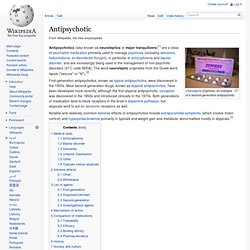
The word neuroleptic originates from the Greek word lepsis ("seizure" or "fit").[2] Atypical antipsychotic. The atypical antipsychotics (AAP) (also known as second generation antipsychotics (SGAs)) are a group of antipsychotic drugs (antipsychotic drugs in general are also known as major tranquilisers and neuroleptics although the latter is usually reserved for the typical antipsychotics) used to treat psychiatric conditions.
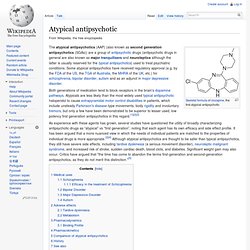
Some atypical antipsychotics have received regulatory approval (e.g. by the FDA of the US, the TGA of Australia, the MHRA of the UK, etc.) for schizophrenia, bipolar disorder, autism and as an adjunct in major depressive disorder. As experience with these agents has grown, several studies have questioned the utility of broadly characterizing antipsychotic drugs as “atypical” vs “first generation”, noting that each agent has its own efficacy and side effect profile. Amisulpride. Amisulpride (sold as Amazeo, Amipride (AU), Amival, Solian (AU, IE, UK, ZA), Soltus, Sulpitac (IN), Sulprix (AU)), is an atypical antipsychotic used to treat psychosis in schizophrenia and episodes of mania in bipolar disorder.
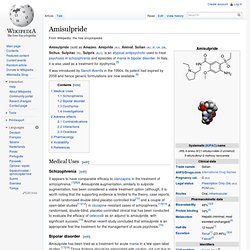
In Italy, it is also used as a treatment for dysthymia.[5] It was introduced by Sanofi-Aventis in the 1990s. Its patent had expired by 2008 and hence generic formulations are now available.[6] Asenapine. Ziprasidone. The oral form of ziprasidone is the hydrochloride salt, ziprasidone hydrochloride.
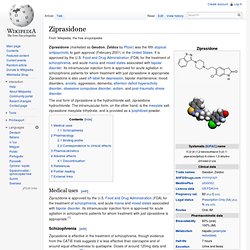
The intramuscular form, on the other hand, is the mesylate salt, ziprasidone mesylate trihydrate, and is provided as a lyophilized powder. Medical uses[edit] Ziprazidone is approved by the U.S. Food and Drug Administration (FDA) for the treatment of schizophrenia, and acute mania and mixed states associated with bipolar disorder. Risperidone. Risperidone, sold under the trade name Risperdal among others, is an antipsychotic medication.[2] It is mainly used to treat schizophrenia, bipolar disorder, and irritability in people with autism.

It is taken either by mouth or by injection into a muscle.[2] The injectable version is long acting and lasts for about two weeks.[3] Common side effects include movement problems, sleepiness, trouble seeing, constipation, and increased weight.[2][4] Serious side effects may include the potentially permanent movement disorder tardive dyskinesia, as well as neuroleptic malignant syndrome, an increased risk of suicide, and high blood sugar levels.[2][3] In older people with psychosis as a result of dementia it may increase the risk of dying.
It is unclear if it is safe for use in pregnancy. Risperidone is an atypical antipsychotic. Its mechanism of action is not entirely clear, but is believed to be related to its action as a dopamine antagonist.[2] Olanzapine. Quetiapine. Quetiapine (/kwɨˈtaɪ.əpiːn/ kwi-TY-ə-peen) (branded as Seroquel, Xeroquel, Ketipinor) is a short-acting atypical antipsychotic approved for the treatment of schizophrenia, bipolar disorder, and along with an antidepressant to treat major depressive disorder.
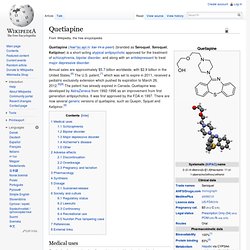
Annual sales are approximately $5.7 billion worldwide, with $2.9 billion in the United States.[6] The U.S. patent,[7] which was set to expire in 2011, received a pediatric exclusivity extension which pushed its expiration to March 26, 2012.[6][8] The patent has already expired in Canada. Quetiapine was developed by AstraZeneca from 1992-1996 as an improvement from first generation antipsychotics. It was first approved by the FDA in 1997. There are now several generic versions of quetiapine, such as Quepin, Syquel and Ketipinor.[9] Medical uses Seroquel XR 150 mg tablet box. Clozapine. Clozapine is an atypical antipsychotic medication used in the treatment of schizophrenia, and is also sometimes used off-label for the treatment of bipolar disorder.
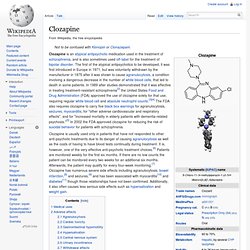
The first of the atypical antipsychotics to be developed, it was first introduced in Europe in 1971, but was voluntarily withdrawn by the manufacturer in 1975 after it was shown to cause agranulocytosis, a condition involving a dangerous decrease in the number of white blood cells, that led to death in some patients. Clozapine is usually used only in patients that have not responded to other anti-psychotic treatments due to its danger of causing agranulocytosis as well as the costs of having to have blood tests continually during treatment.
It is, however, one of the very effective anti-psychotic treatment choices.[6] Patients are monitored weekly for the first six months. If there are no low counts the patient can be monitored every two weeks for an additional six months. Aripiprazole. Cannabidiol. Cannabidiol (CBD) is one of at least 60 active cannabinoids identified in cannabis.[4] It is a major constituent of the plant, accounting for up to 40% of the plant's extract, as a non-psychotropic phytocannabinoid.[5] CBD is considered to have a wider scope of medical applications than tetrahydrocannabinol (THC).[5] An orally-administered liquid containing CBD has received orphan drug status in the US, for use as a treatment for dravet syndrome under the brand name, Epidiolex.[6] Clinical applications[edit] The bud of a Cannabis sativa flower coated with trichomes Antimicrobial actions[edit] CBD absorbed transcutaneously may attenuate the increased sebum production at the root of acne.[7] Neurological effects[edit]
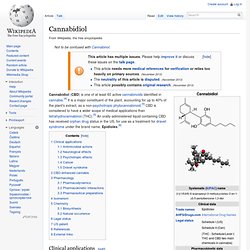
Typical antipsychotic. Typical antipsychotics Typical antipsychotics (sometimes referred to as first generation antipsychotics, conventional antipsychotics, classical neuroleptics, traditional antipsychotics, or major tranquilizers) are a class of antipsychotic drugs first developed in the 1950s and used to treat psychosis (in particular, schizophrenia).
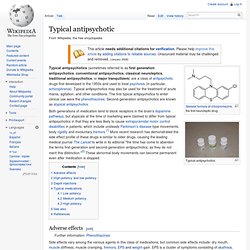
Typical antipsychotics may also be used for the treatment of acute mania, agitation, and other conditions. The first typical antipsychotics to enter clinical use were the phenothiazines. Second-generation antipsychotics are known as atypical antipsychotics. Adverse effects[edit] Phenothiazine. Phenothiazine is an organic compound that occurs in various antipsychotic and antihistaminic drugs.

It has the formula S(C6H4)2NH. This yellow tricyclic compound is soluble in acetic acid, benzene, and ether. The compound is related to the thiazine-class of heterocyclic compounds. Derivatives of the parent compound find wide use as drugs. Synthesis[edit] Chlorpromazine. Chlorpromazine (as chlorpromazine hydrochloride, abbreviated CPZ; marketed in the United States as Thorazine and elsewhere as Largactil or Megaphen) is a dopamine antagonist of the typical antipsychotic class of medications possessing additional antiadrenergic, antiserotonergic, anticholinergic and antihistaminergic properties used to treat schizophrenia.[3][4] First synthesized on December 11, 1950, chlorpromazine was the first drug developed with specific antipsychotic action, and would serve as the prototype for the phenothiazine class of drugs, which later grew to comprise several other agents.
The introduction of chlorpromazine into clinical use has been described as the single greatest advance in psychiatric care, dramatically improving the prognosis of patients in psychiatric hospitals worldwide.[5] Perphenazine. Perphenazine is a typical antipsychotic drug. Trifluoperazine. Trifluoperazine (Eskazinyl, Eskazine, Jatroneural, Modalina, Stelazine, Terfluzine, Trifluoperaz, Triftazin) is a typical antipsychotic of the phenothiazine chemical class. Uses[edit] The primary application of trifluoperazine is for schizophrenia. Fluphenazine. Fluphenazine is a typical antipsychotic drug used for the treatment of psychoses such as schizophrenia, manic phases of bipolar disorder, agitation, and dementia. It belongs to the piperazine class of phenothiazines.
The medication may help control symptoms by blocking the reuptake of dopamine in the brain. It is not entirely known how the medication works. Dopamine may be elevated in people with schizophrenia or other psychoses. Prochlorperazine. Indications[edit] Prochlorperazine is a phenothiazine drug. Most drugs in this category are used as anti-psychotics (neuroleptics).[1] Neuroleptic means "nerve seizing," and describes the semi-paralyzing effect these drugs have on the brain and nervous system. Thioridazine. Thioridazine (Mellaril (DE, BD, ET, ID, BR), Melleril (withdrawn worldwide in 2005[2]), Sonapax (RU), Thioril (IN)) is a piperidine typical antipsychotic drug belonging to the phenothiazine drug group and was previously widely used in the treatment of schizophrenia and psychosis.
Due to concerns about cardiotoxicity and retinopathy at high doses this drug has been withdrawn in many countries (including the UK and Australia) and in other countries it is not commonly prescribed, reserved for patients who have failed to respond to, or have contraindications for, more widely used antipsychotics. In older references, it is sometimes described as atypical,[3] but more recently it is usually described as typical,[4] with the term "atypical" usually reserved for agents showing D4 selectivity or serotonin antagonism. Its perceived atypical effects (namely its comparatively low propensity for extrapyramidal side effects) are likely the result of its potent anticholinergic effects.
Thioxanthene. Thioxanthene is a chemical compound in which the oxygen atom in xanthene is replaced with a sulfur atom. It is also related to phenothiazine. Flupentixol. Zuclopenthixol. Chlorprothixene. Thiothixene. Butyrophenone. Haloperidol. Droperidol.